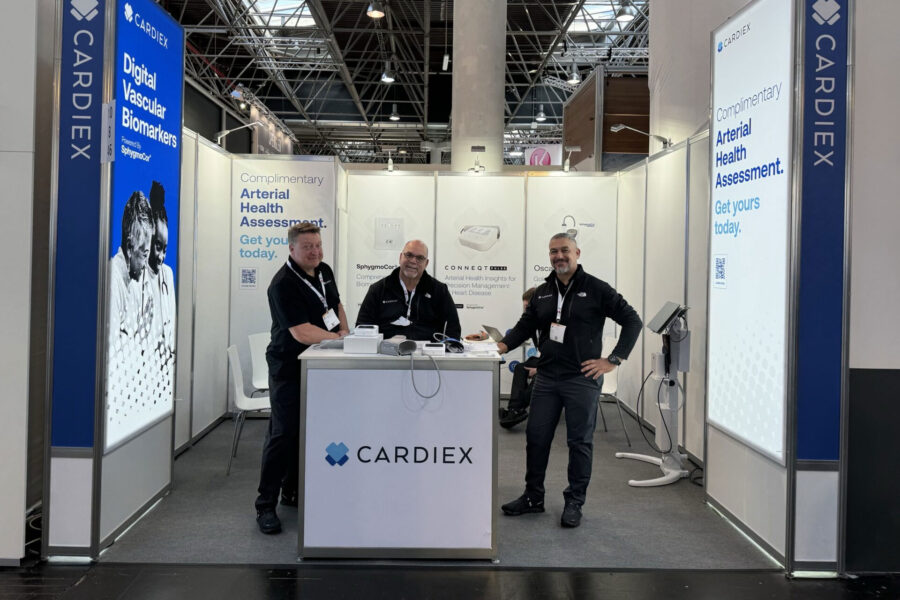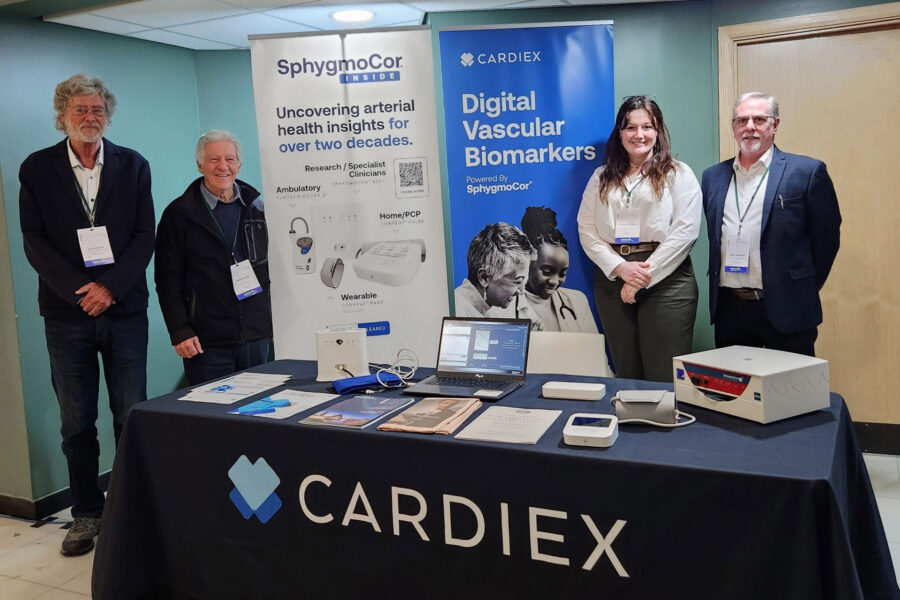
Vascular Age: How Old Are You Really? It’s All in the Pulse
December 7, 2021What is Vascular Aging?
Consider two men, both 60 years old, but one of them looks about a decade younger than the other. Why? Many factors can be involved, ranging from genetics to smoking history, presence of chronic disease, occupation, and dietary choices, among others. But did you know that vascular health, and in particular vascular aging, is on that list of factors?
Vascular aging: an overview
What is vascular aging? Let’s begin with cardiovascular disease, which has the unique distinction of being the underlying cause of death of about one third of all deaths in the United States. In 2016, coronary heart disease was the main cause (43.2%) of deaths attributed to cardiovascular disease among both men and women, followed by stroke (16.9%), hypertension (9.8%), and heart failure (9.3%). (1)What does this have to do with vascular aging?
Vascular aging has been identified as a cardiovascular risk factor,(2,3) joining the ranks of high LDL and low HDL cholesterol, smoking, sedentary lifestyle, poor diet, obesity, hypertension, age, and family history of heart disease, stroke, or other cardiovascular disease. Also known as early vascular aging, heart age, or cardiovascular risk (CVR) age, vascular aging is a process that starts early in life and continues throughout normal aging to the changes that occur related to atherosclerosis, or hardening of the arteries. In fact, vascular aging is the result of arterial stiffness.
The aging process affects all three layers of the walls of the arteries:
- The intima, which is associated with endothelial dysfunction (characterized by inflammation and a reduction in vasodilation), a decline in nitric oxide production, and eventually the early signs of atherosclerosis
- The media, which shows decreasing levels of elastin and an increase in collagen
- The adventitia, which manifests with impaired innervation and neuronal control and the development of fat deposits that may cause an increase in local inflammation that have a negative impact on vasodilation(4)
Aging of the arterial system involves not only the large arteries but also the smaller ones. Elevated blood pressure, for example, can change the structure and integrity of smaller arteries. Other damage to the vascular system occurs when something called pulse waves are transmitted to the microvascular of stiff large arteries.
Pulse waves are generated during each heart contraction. The waves travel from the heart until they come up against some resistance or a branching point, which in turn determines the appearance of the reflected wave. When we are young, our arteries are more elastic, so the reflected waves occur later in the cardiac cycle. The reflection of the waves also sends part of the energy to the central aorta, which results in limited energy to the periphery, thus preventing damage to the microcirculation.
In older individuals, however, the reflected waves occur earlier and thus with greater pulse wave velocity (PWV). This increases systolic blood pressure, which in turn can increase cardiac workload. PWV is an important biomarker of vascular damage and in predicting a person’s cardiovascular risk. (5-7)
Overall, vascular aging impacts the entire vascular system, including large and small arteries and both macro- and microcirculation. As a result, it is also associated with vascular brain damage, which can mean impaired cognitive function.(8-10)
Causes of vascular aging
We have already touched on a few of the causes of vascular aging, but let’s identify more of them here. They include:
- Diabetes mellitus, which has been called “an independent and important risk factor for functional and structural damage to the arterial wall, resulting in early arterial stiffness.”
- Hypertension
- Smoking
- High bad (LDL) cholesterol and low good (HDL) cholesterol
- Advancing age
- Calcification—calcium deposits in the arteries
- Family history of cardiovascular disease
- Elevated C-reactive protein, an inflammatory marker that also reduces levels of endogenous nitric oxide, an important vasodilator (opens up blood vessels, which improves blood flow and lowers blood pressure)
- Elevated triglyceride levels
These are some, but not all, of the causes of vascular aging. The good news is that most of them are modifiable factors.
Diagnosing vascular aging
The diagnosis of vascular aging centers around measuring arterial stiffness. Arterial stiffness is when the arteries lose their suppleness, resulting in an inability of the arteries to properly regulate blood flow and pressure. This condition also can lead to organ damage (e.g., heart attack, dementia, kidney failure, stroke, etc), as stiffening also damages capillaries that nourish the organs.
The most advanced clinical and noninvasive way to diagnose arterial stiffness is use of ATCOR’s SphygmoCor® XCEL. This technology allows physicians to accurately measure central blood pressure, which provides information that is much more predictive of cardiovascular risk than traditional brachial pressure, which is measured with a brachial cuff sphygmomanometer.
The SphygmoCor XCEL measures central arterial pressure waveform and pulse wave velocity as well as provides assessment of arterial stiffness using waveform analysis, which includes augmentation index and reflected wave magnitude.
What does all of this mean? Here’s a brief explanation:
Pulse wave velocity: A measure of arterial stiffness, or the rate at which pressure waves travel down your blood vessels. When the left ventricle of the heart contracts and blood is ejected into the ascending aorta, a pressure wave is generated. The velocity (speed) of this movement provides clinicians with a measurement of arterial compliance (elasticity). As we get older and/or the integrity of the artery walls changes, the artery walls become stiffer and the speed of the pressure waves increases.
Augmentation index: This is an indirect measure of arterial stiffness and it increases with age. The measure is derived from the ascending aortic pressure waveform.
Reflected wave magnitude: This is defined as the ratio of the amplitude of a backward wave to a forward wave. Basically, it is a strong predictor of incident heart failure and cardiovascular events.
The combination of these data allows clinicians to make the most accurate evaluation currently possible of arterial stiffness and thus vascular aging. Such an assessment is important can be used to help prevent cardiovascular disease by identifying individuals who are at high risk and thus take steps to prevent or minimize vascular damage and other consequences of vascular aging.
Sources
(1) American Heart Association. Heart disease and stroke statistics—2019 at a glance.
(2) Laurent S. Defining vascular aging and cardiovascular risk. Journal of Hypertension 2012 Jun; 30: S3-S8
(3) Cuende JI. Vascular age versus cardiovascular risk: clarifying concepts. Revista Espnola de Cardiologia 2016 Mar; 69(3): 243-46
(4) Yudkin JS et al. “Vasocrine” signalling from perivascular fat: a mechanism linking insulin resistance to vascular disease. Lancet 2005; 365: 1817-20.
(5) Nichols W et al. McDonald’s blood flow in arteries: theoretical, experimental and clinical principles. 6th ed. New York: CRC Press; 2011.
(6) Safar ME et al. Current perspectives on arterial stiffness and pulse pressure in hypertension and cardiovascular diseases. Circulation 2003; 107(22):2864–69.
(7) Luana de Rezende Mikael et al. Vascular aging and arterial stiffness. Arq Bras Cardiology 2017 Sep; 109(3): 253-58
(8) Scuteri A et al. Microvascular brain damage with aging and hypertension: pathophysiological consideration and clinical implications. Journal of Hypertension 2011; 29:1469-77.
(9) Mitchell GF et al. Arterial stiffness, pressure and flow pulsatility and brain structure and function: the Age, Gene/Environment Susceptibility – Reykjavik study. Brain 2011; 134(Pt 11):3398-3407.
(10) Scuteri A et al. Aortic stiffness and hypotension episodes are associated with impaired cognitive function in older subjects with subjective complaints of memory loss. International Journal of Cardiology 2013; 169:371-77.



